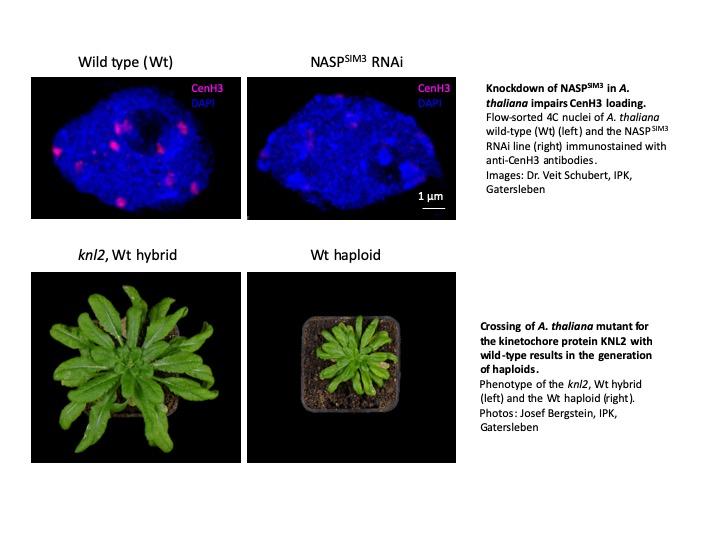Investigating the roles of kinetochores in cell division

Credit: Images: Dr. Veit Schubert, IPK, Gatersleben
Photos: Josef Bergstein, IPK, Gatersleben
The division of cells is highly-regulated and complex process which requires the organised collaboration of a multitude of different cellular components. Although the basic principles are known, many components and their workings are still unidentified. Scientists from the project group “Kinetochore Biology” at the IPK in Gatersleben are shedding light on the diverse landscape of kinetochores. Kinetochores are required for the interaction with the spindle apparatus and segregation of the chromosomes. Within an international collaboration, the scientists recently uncovered a chaperone protein which affects loading of CenH3 to centromeres – a crucial step for the assembly of the kinetochores. Knowledge about the regulation of centromeres will help develop methods to speed-up the breeding process of crop plants.
During somatic cell division, chromosomes are split into sister chromatids thanks to the pulling forces of the spindles apparatus. In order for this to happen correctly, the fibres of the spindle apparatus need to link to the chromosomes at the correct position. Here kinetochores come into play. Kinetochores are assembled at the correct chromosomal positions, marked by so-called centromeres. From there, they attach to the spindle apparatus and aid the segregation of the chromosomes during mitosis as well as meiosis. However, the entire segregation process comes to a halt if the function of the centromere is impaired. Led by Dr Inna Lermontova, researchers from the Leibniz Institute of Plant Genetics and Crop Plant Research (IPK) in Gatersleben in collaboration with other institutes have uncovered a chaperone which can affect the formation of the crucial centromere component CenH3.
The incorporation of the histone variant CenH3 in the chromatin determines the positioning of the centromeres. By binding to CenH3, the protein NASPSIM3 takes on the role of a chaperone, escorting CenH3 within the cell and assuring the correct deposition of this histone. The scientists showed that the reduced expression of NASPSIM3 negatively affects CenH3 deposition, therefore reducing centromere formation, and in turn kinetochore assembly.
The researchers from the project group “Kinetochore Biology” will continue to investigate the pathways effecting kinetochores. Dr Lermontova let us know: “There are more than 100 different kinetochore proteins and only few of them have been described and characterised functionally in plants. In the group, we are focussing on elucidating the mechanism of kinetochore assembly and function.”
Moreover, research on the kinetochore has extensive potential in applied science. For instance, in the development of haploid inducer lines for plant breeding. Dr Lermontova: “Haploid induction is very important for plant breeding. When for example cereal plant breeders would like to fix a trait, it normally takes seven to eight generations, meaning seven to eight years to generate pure homozygous lines to stabilize the improved trait. By generating haploid lines, you can fix this within a single generation, thus increasing the efficiency.”
At the IPK Dr Lermontova has demonstrated that the mutant for kinetochore protein KNL2 of Arabidopsis induces haploids in crosses with wild type and that the haploid induction efficiency can be increased after exposure of haploid inducer line to stress conditions (I. Lermontova, WO 2017/067714). Compared to already existing in situ haploid induction approaches the KNL2-based approach has a number of positive features: It showcases a comparatively high haploid induction efficiency and viable homozygous mutants with only slightly reduced fitness can be generated as haploid inducers. Further, the KNL2-based haploid induction approach is completely established and patented at the IPK.
Dr Lermontova: “The next step is now to transfer this to crop species. For this reason, we are currently in discussion with plant breeding companies. However, thoroughly understanding of the mechanisms first is important. One cannot improve crop species if it is not understood what the underlying mechanisms are.”
###
Media Contact
Dr Inna Lermontova
[email protected]
49-394-825-570
Related Journal Article
http://dx.




